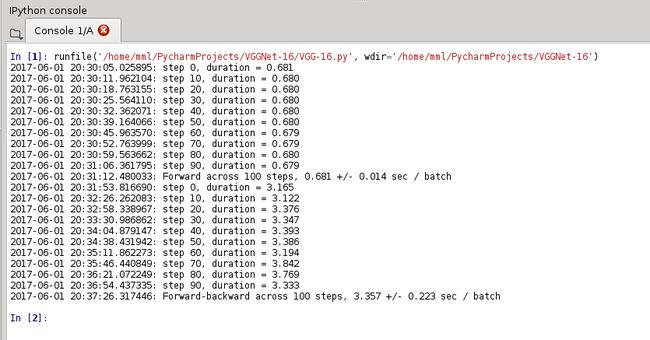VGG16简介
Tensorflow简单实现代码及详细注释
#!/usr/bin/env python2
# -*- coding: utf-8 -*-
# 载入几个系统库和tensorflow
from datetime import datetime
import math
import time
import tensorflow as tf
# VGG包含很多卷积,函数conv_op创建卷积层并把本层参数存入参数列表
# input_op是输入的tensor
# name是本层名称
# kh卷积核高
# kw卷积核宽
# n_out是卷积核的数量,即输出通道数
# dh步长的高
# dw步长的宽
# p是参数列表
def conv_op(input_op, name, kh, kw, n_out, dh, dw, p):
# get_shape获得输入tensor的通道数
# 224*224*3的图片就是最后的3
n_in = input_op.get_shape()[-1].value
# name_scope将scope内生成的variable自动命名为name/xxx
# 用于区分不同卷积层的组件
with tf.name_scope(name) as scope:
# 卷积核参数由get_variable函数创建
# shape即卷积核的高,宽,输入通道数,输出通道数
kernel = tf.get_variable(scope+"w", shape=[kh,kw,n_in,n_out], dtype=tf.float32,
initializer=tf.contrib.layers.xavier_initializer_conv2d())
# conv2d对输入的tensor进行卷积处理
# tf.nn.conv2d(input, filter, strides, padding, use_cudnn_on_gpu=None, name=None)
# input是输入的图像tensor shape=[batch, in_height, in_width, in_channels]
# [训练时一个batch的图片数量, 图片高度, 图片宽度, 图像通道数]
# filter是卷积核tensor shape=[filter_height, filter_width, in_channels, out_channels]
# [卷积核的高度,卷积核的宽度,图像通道数,卷积核个数]
# strides卷积时在每一维上的步长,strides[0]=strides[3]=1
# padding drop or zeropad
conv = tf.nn.conv2d(input_op, kernel, (1, dh, dw, 1), padding='SAME')
# bias使用tf.constant赋值为0
bias_init_val = tf.constant(0.0, shape=[n_out], dtype=tf.float32)
# tf.variable再将其转换成可训练的参数
biases = tf.Variable(bias_init_val, trainable=True, name='b')
# tf.nn.bias_add将卷积结果和bias相加
z = tf.nn.bias_add(conv,biases)
# 使用relu对卷积结果进行非线性处理
activation = tf.nn.relu(z, name=scope)
# 把卷积层使用到的参数添加到参数列表p
p += [kernel, biases]
return activation
# 定义 创建全连接层 函数fc_op
def fc_op(input_op, name, n_out, p):
# 同样获得输入图片tensor的通道数
n_in = input_op.get_shape()[-1].value
with tf.name_scope(name) as scope:
# 同样使用get_variable创建全连接层的参数,只不过参数纬度只有两个:输入和输出通道数
# 参数初始化方法使用xavier_initializer
kernel = tf.get_variable(scope+"w", shape=[n_in, n_out], dtype=tf.float32,
initializer=tf.contrib.layers.xavier_initializer())
# bias利用constant函数初始化为较小的值0.1,而不是0
biases = tf.Variable(tf.constant(0.1, shape=[n_out], dtype=tf.float32), name='b')
# 这里使用tf.nn.relu_layer,对输入变量input_op和kernel做矩阵乘法并加上biases
# 再做relu非线性变换得到activation
activation = tf.nn.relu_layer(input_op, kernel, biases, name= scope)
# 把全连接层使用到的参数添加到参数列表p
p += [kernel, biases]
return activation
# 定义 创建最大池化层 函数mpool_op
def mpool_op(input_op, name, kh, kw, dh, dw):
# 直接使用tf.nn.max_pool,输入为图片tensor,池化尺寸为kh*kw,步长为dh*dw,padding为same
return tf.nn.max_pool(input_op,
ksize=[1, kh, kw, 1],
strides=[1, dh, dw, 1],
padding='SAME',
name=name)
# 完成了 卷积层,全连接层,pooling层 的创建函数
# 下面开始创建VGG16的网络结构
# inference_op是创建网络结构的函数
# input_op是输入的图像tensor shape=[batch, in_height, in_width, in_channels]
# keep_prob是控制dropout比率的一个placeholder
def inference_op(input_op,keep_prob):
# 初始化参数p列表
p = []
# VGG16包含6个部分,前面5段卷积,最后一段全连接
# 每段卷积包含多个卷积层和pooling层
# 下面是第一段卷积,包含2个卷积层和一个pooling层
# 利用前面定义好的函数conv_op,mpool_op 创建这些层
# 第一段卷积的第一个卷积层 卷积核3*3,共64个卷积核(输出通道数),步长1*1
# input_op:224*224*3 输出尺寸224*224*64
conv1_1 = conv_op(input_op, name="conv1_1", kh=3, kw=3, n_out=64, dh=1,
dw=1, p=p)
# 第一段卷积的第2个卷积层 卷积核3*3,共64个卷积核(输出通道数),步长1*1
# input_op:224*224*64 输出尺寸224*224*64
conv1_2 = conv_op(conv1_1, name="conv1_2", kh=3, kw=3, n_out=64, dh=1,
dw=1, p=p)
# 第一段卷积的pooling层,核2*2,步长2*2
# input_op:224*224*64 输出尺寸112*112*64
pool1 = mpool_op(conv1_2, name="pool1", kh=2, kw=2, dh=2, dw=2)
# 下面是第2段卷积,包含2个卷积层和一个pooling层
# 第2段卷积的第一个卷积层 卷积核3*3,共128个卷积核(输出通道数),步长1*1
# input_op:112*112*64 输出尺寸112*112*128
conv2_1 = conv_op(pool1, name="conv2_1", kh=3, kw=3, n_out=128, dh=1,
dw=1, p=p)
# input_op:112*112*128 输出尺寸112*112*128
conv2_2 = conv_op(conv2_1, name="conv2_2", kh=3, kw=3, n_out=128, dh=1,
dw=1, p=p)
# input_op:112*112*128 输出尺寸56*56*128
pool2 = mpool_op(conv2_2, name="pool2", kh=2, kw=2, dh=2, dw=2)
# 下面是第3段卷积,包含3个卷积层和一个pooling层
# 第3段卷积的第一个卷积层 卷积核3*3,共256个卷积核(输出通道数),步长1*1
# input_op:56*56*128 输出尺寸56*56*256
conv3_1 = conv_op(pool2, name="conv3_1", kh=3, kw=3, n_out=256, dh=1,
dw=1, p=p)
# input_op:56*56*256 输出尺寸56*56*256
conv3_2 = conv_op(conv3_1, name="conv3_2", kh=3, kw=3, n_out=256, dh=1,
dw=1, p=p)
# input_op:56*56*256 输出尺寸56*56*256
conv3_3 = conv_op(conv3_2, name="conv3_3", kh=3, kw=3, n_out=256, dh=1,
dw=1, p=p)
# input_op:56*56*256 输出尺寸28*28*256
pool3 = mpool_op(conv3_3, name="pool3", kh=2, kw=2, dh=2, dw=2)
# 下面是第4段卷积,包含3个卷积层和一个pooling层
# 第3段卷积的第一个卷积层 卷积核3*3,共512个卷积核(输出通道数),步长1*1
# input_op:28*28*256 输出尺寸28*28*512
conv4_1 = conv_op(pool3, name="conv4_1", kh=3, kw=3, n_out=512, dh=1,
dw=1, p=p)
# input_op:28*28*512 输出尺寸28*28*512
conv4_2 = conv_op(conv4_1, name="conv4_2", kh=3, kw=3, n_out=512, dh=1,
dw=1, p=p)
# input_op:28*28*512 输出尺寸28*28*512
conv4_3 = conv_op(conv4_2, name="conv4_3", kh=3, kw=3, n_out=512, dh=1,
dw=1, p=p)
# input_op:28*28*512 输出尺寸14*14*512
pool4 = mpool_op(conv4_3, name="pool4", kh=2, kw=2, dh=2, dw=2)
# 前面4段卷积发现,VGG16每段卷积都是把图像面积变为1/4,但是通道数翻倍
# 因此图像tensor的总尺寸缩小一半
# 下面是第5段卷积,包含3个卷积层和一个pooling层
# 第3段卷积的第一个卷积层 卷积核3*3,共512个卷积核(输出通道数),步长1*1
# input_op:14*14*512 输出尺寸14*14*512
conv5_1 = conv_op(pool4, name="conv5_1", kh=3, kw=3, n_out=512, dh=1,
dw=1, p=p)
# input_op:14*14*512 输出尺寸14*14*512
conv5_2 = conv_op(conv5_1, name="conv5_2", kh=3, kw=3, n_out=512, dh=1,
dw=1, p=p)
# input_op:14*14*512 输出尺寸14*14*512
conv5_3 = conv_op(conv5_2, name="conv5_3", kh=3, kw=3, n_out=512, dh=1,
dw=1, p=p)
# input_op:28*28*512 输出尺寸7*7*512
pool5 = mpool_op(conv5_3, name="pool5", kh=2, kw=2, dh=2, dw=2)
# 将第五段卷积网络的结果扁平化
# reshape将每张图片变为7*7*512=25088的一维向量
shp = pool5.get_shape()
flattened_shape = shp[1].value * shp[2].value * shp[3].value
# tf.reshape(tensor, shape, name=None) 将tensor变换为参数shape的形式。
resh1 = tf.reshape(pool5, [-1, flattened_shape], name="resh1")
# 第一个全连接层,是一个隐藏节点数为4096的全连接层
# 后面接一个dropout层,训练时保留率为0.5,预测时为1.0
fc6 = fc_op(resh1, name="fc6", n_out=4096, p=p)
fc6_drop = tf.nn.dropout(fc6, keep_prob, name="fc6_drop")
# 第2个全连接层,是一个隐藏节点数为4096的全连接层
# 后面接一个dropout层,训练时保留率为0.5,预测时为1.0
fc7 = fc_op(fc6_drop, name="fc7", n_out=4096, p=p)
fc7_drop = tf.nn.dropout(fc7, keep_prob, name="fc7_drop")
# 最后是一个1000个输出节点的全连接层
# 利用softmax输出分类概率
# argmax输出概率最大的类别
fc8 = fc_op(fc7_drop, name="fc8", n_out=1000, p=p)
softmax = tf.nn.softmax(fc8)
predictions = tf.argmax(softmax, 1)
return predictions, softmax, fc8, p
# 评测VGGNet每轮计算时间的函数
# session Tensorflow的session
# target需要评测的运算算子
def time_tensorflow_run(session, target, feed, info_string): # 与AlexNet非常相似,session参数一点点区别
# num_steps_burn_in预热轮数,前几轮有显存加载,可以跳过时间评测
# 只计算10轮迭代后的计算时间
num_steps_burn_in = 10
# 总时间
total_duration = 0.0
# 总时间的平方
total_duration_squared = 0.0
# 进行num_batches + num_steps_burn_in次迭代计算
for i in range(num_batches + num_steps_burn_in):
# 使用time.time()记录时间
start_time = time.time()
# 每次迭代通过session.run执行
_ = session.run(target, feed_dict=feed) # 引入feed_dict方便后面传入keep_prob来控制Dropout层的保留比率
duration = time.time() - start_time
# 在预热之后
if i >= num_steps_burn_in:
# 每10轮迭代显示当前迭代所需时间
if not i % 10:
print '%s: step %d, duration = %.3f' % (datetime.now(), i - num_steps_burn_in, duration)
total_duration += duration
total_duration_squared += duration * duration
# 计算每轮迭代的平均耗时和标准差
mn = total_duration / num_batches
vr = total_duration_squared / num_batches - mn * mn
sd = math.sqrt(vr)
print '%s: %s across %d steps, %.3f +/- %.3f sec / batch' % (datetime.now(), info_string, num_batches, mn, sd)
def run_benchmark():
# 并不使用imagenet数据集训练,而是使用随机图片数据测试前奎和反馈耗时
with tf.Graph().as_default():
image_size = 224
# 利用随机数生成之前的图片tensor
images = tf.Variable(tf.random_normal([batch_size, # 生成随机的图片224*224
image_size,
image_size, 3],
dtype = tf.float32,
stddev=1e-1)) # 标准差为0.1的正态分布的随机数
keep_prob = tf.placeholder(tf.float32)
predictions, softmax, fc8, p = inference_op(images, keep_prob) # 构建网络结构获得参数列表
# 通过tf.session创建新的session,并通过global_variable初始化所有参数
# 并通过run运行该session 只有运行run并feed数据运算才真正执行
init = tf.global_variables_initializer() # 初始化全局参数
sess = tf.Session() # 创建session
sess.run(init)
time_tensorflow_run(sess, predictions, {keep_prob: 1.0}, "Forward") # 预测时节点保留率
objective = tf.nn.l2_loss(fc8) # 计算VGGNet-16最后的全连接层的输出fc8的L2 loss
grad = tf.gradients(objective, p) # 使用tf.gradients求相对于这个loss的所有模型参数的梯度
time_tensorflow_run(sess, grad, {keep_prob: 0.5}, "Forward-backward") # 这里的target为求解梯度的操作grad
batch_size = 32 # VGGNet-16模型的体积较大,如果使用较大的batch_size,GPU显存会不够用
num_batches = 100
run_benchmark()
# VGGNet-16的计算复杂度相比AlexNet确实高了很多,不过准确率有了很大提升
结果
